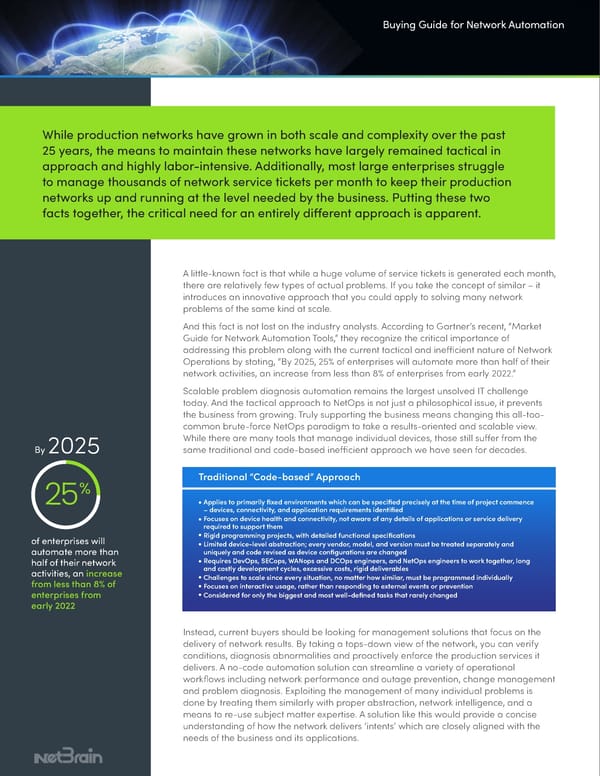Buying Guide for Network Automation While production networks have grown in both scale and complexity over the past 25 years, the means to maintain these networks have largely remained tactical in approach and highly labor-intensive. Additionally, most large enterprises struggle to manage thousands of network service tickets per month to keep their production networks up and running at the level needed by the business. Putting these two facts together, the critical need for an entirely different approach is apparent. A little-known fact is that while a huge volume of service tickets is generated each month, there are relatively few types of actual problems. If you take the concept of similar – it introduces an innovative approach that you could apply to solving many network problems of the same kind at scale. And this fact is not lost on the industry analysts. According to Gartner’s recent, “Market Guide for Network Automation Tools,” they recognize the critical importance of addressing this problem along with the current tactical and inefficient nature of Network Operations by stating, “By 2025, 25% of enterprises will automate more than half of their network activities, an increase from less than 8% of enterprises from early 2022.” Scalable problem diagnosis automation remains the largest unsolved IT challenge today. And the tactical approach to NetOps is not just a philosophical issue, it prevents the business from growing. Truly supporting the business means changing this all-too- common brute-force NetOps paradigm to take a results-oriented and scalable view. While there are many tools that manage individual devices, those still suffer from the By 2025 same traditional and code-based inefficient approach we have seen for decades. % Traditional “Code-based” Approach 25 Applies to primarily fixed environments which can be specified precisely at the time of project commence – devices, connectivity, and application requirements identified Focuses on device health and connectivity, not aware of any details of applications or service delivery required to support them of enterprises will Rigid programming projects, with detailed functional specifications Limited device-level abstraction; every vendor, model, and version must be treated separately and automate more than uniquely and code revised as device configurations are changed half of their network Requires DevOps, SECops, WANops and DCOps engineers, and NetOps engineers to work together, long activities, an increase and costly development cycles, excessive costs, rigid deliverables from less than 8% of Challenges to scale since every situation, no matter how similar, must be programmed individually Focuses on interactive usage, rather than responding to external events or prevention enterprises from Considered for only the biggest and most well-defined tasks that rarely changed early 2022 Instead, current buyers should be looking for management solutions that focus on the delivery of network results. By taking a tops-down view of the network, you can verify conditions, diagnosis abnormalities and proactively enforce the production services it delivers. A no-code automation solution can streamline a variety of operational workflows including network performance and outage prevention, change management and problem diagnosis. Exploiting the management of many individual problems is done by treating them similarly with proper abstraction, network intelligence, and a means to re-use subject matter expertise. A solution like this would provide a concise understanding of how the network delivers ‘intents’ which are closely aligned with the needs of the business and its applications.
 NetBrain Buying Guide For Problem Diagnosis Automation 5-5-22 Page 1 Page 3
NetBrain Buying Guide For Problem Diagnosis Automation 5-5-22 Page 1 Page 3